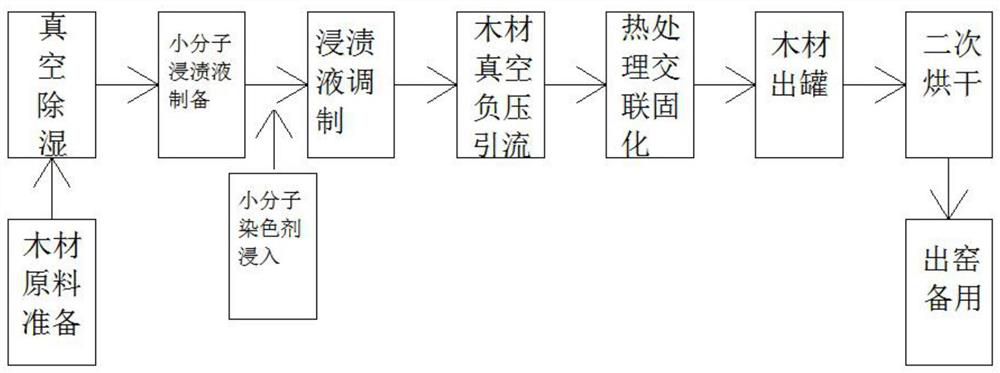Method for changing color permeability of wood
A permeability and wood technology, which is applied in wood treatment, impregnation of wood, wood impregnation, etc., can solve the problems of inability to achieve wood color permeability, etc., and achieve the effect of beautiful color, improved physical and mechanical properties, and good color fastness
- Summary
- Abstract
- Description
- Claims
- Application Information
AI Technical Summary
Problems solved by technology
Method used
Image
Examples
Embodiment 1
[0034] A method for changing the color permeability of wood, comprising the steps of,
[0035] S1, vacuum dehumidification: put the wet wood after sawing the log into the vacuum dehumidifier, vacuum dehumidify the moisture content of the wood to 8-15%, and set it aside;
[0036] S2, preparation of small molecule impregnation solution;
[0037] S3, small molecule dye immersion; select a suitable small molecule dye, and add small molecule dye during the preparation of the small molecule dipping solution;
[0038] S3, preparation of impregnating solution: a. Put 1.8-2.5 parts of water in the mass-number ratio into the agitator, and raise the temperature to 30-50°C; b. Add 1 part in mass-number ratio of small molecule dye For small molecule impregnating solution, heat the mixed solution to 40-60°C and stir until uniform to make a medicinal solution;
[0039] S4, wood vacuum negative pressure catheter drainage: put the sawn timber with a moisture content of 8-15% in the impregnat...
Embodiment 1-1
[0045] a. Preparation of raw materials for the production of small molecule impregnation solution: the small molecule impregnation solution is composed of the following raw materials in mass fraction ratio: 300 parts of polyoxymethylene (POM), 900 parts of urea, 0.3 parts of sodium carboxymethylcellulose, and 80 parts of ammonia water , 105 parts of melamine, 95 parts of polyvinyl alcohol, 0.9 part of hexamethylenetetramine and 0.5 part of diethylene glycol, 40 parts of borax, 20 parts of boric acid, 15 parts of magnesium chloride, small molecule color changer.
[0046]b. One-time feeding: add polyoxymethylene, polyvinyl alcohol, ammonia water, hexamethylenetetramine, melamine, sodium carboxymethyl cellulose into the reaction kettle according to the ratio of the above parts, and add three-thirds of the total amount of urea first. One part of urea, after stirring well, adjust the pH value to 8.5 with sodium hydroxide;
[0047] c. Secondary urea: heat up to 80-85°C, keep for 10-...
Embodiment 1-2
[0056] The preparation steps of the small molecule impregnating solution include: a. The preparation of raw materials for the production of the small molecule impregnating solution: the small molecule impregnating solution is composed of the following raw materials in mass fraction ratio: 350 parts of polyoxymethylene (POM), 1050 parts of urea, carboxymethyl fiber 0.6 parts of plain sodium, 95 parts of ammonia water, 125 parts of melamine, 115 parts of polyvinyl alcohol, 1.2 parts of hexamethylenetetramine and 0.9 parts of diethylene glycol, 60 parts of borax, 30 parts of boric acid, 5 parts of magnesium chloride, small molecule color change agent.
[0057] b. One-time feeding: add polyoxymethylene, polyvinyl alcohol, ammonia water, hexamethylenetetramine, melamine, sodium carboxymethyl cellulose into the reaction kettle according to the ratio of the above parts, and add three-thirds of the total amount of urea first. One part of urea, after stirring well, adjust the pH value ...
PUM
 Login to View More
Login to View More Abstract
Description
Claims
Application Information
 Login to View More
Login to View More - R&D
- Intellectual Property
- Life Sciences
- Materials
- Tech Scout
- Unparalleled Data Quality
- Higher Quality Content
- 60% Fewer Hallucinations
Browse by: Latest US Patents, China's latest patents, Technical Efficacy Thesaurus, Application Domain, Technology Topic, Popular Technical Reports.
© 2025 PatSnap. All rights reserved.Legal|Privacy policy|Modern Slavery Act Transparency Statement|Sitemap|About US| Contact US: help@patsnap.com


